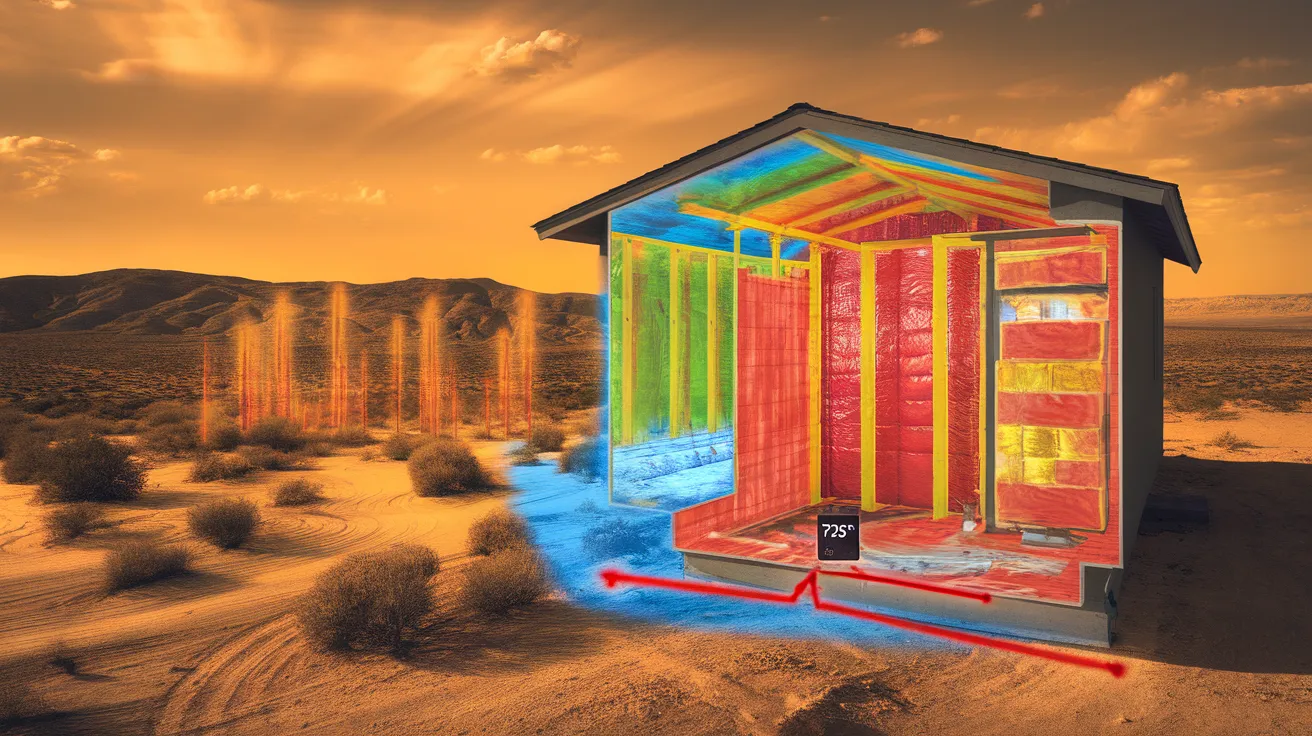Keeping cool in the Southern Utah heat can be economical and energy-conscious. Focus on quality home insulation, programmable thermostat use, and regular AC maintenance. Take advantage of passive cooling, add window protection, and look into the perks of energy efficient ductless systems. Pay attention to the impact of strategic landscaping, such as strategic tree placement and cooling ground surfaces, which can minimize heat buildup. Want to discover the details of turning your living space into a summer oasis without maxing out your AC and increasing energy costs? Keep reading!

Essential Points
Understanding the Fundamentals of Energy-Efficient Air Conditioning
Although many believe that turning up the air conditioner is the sole solution to cool your living space during summer, understanding the basics of energy-efficient cooling can change your perspective. It's not just about comfort, it's additionally about energy conservation. Remember that cooling techniques like insulation, shading, and ventilation can significantly decrease your energy usage. By insulating your home, you're preventing cool air from escaping, thereby minimizing the need to keep running your AC. Using window covers, especially those in direct sunlight, can minimize heat buildup. And ventilation, whether natural or mechanical, helps promote airflow, ensuring a comfortable environment. A more energy-efficient home isn't just economical, it's environmentally-friendly too.
Choosing the Ideal Air Conditioning System
Having knowledge of energy-saving cooling techniques is a solid basis. But selecting the ideal air conditioning system is essential to maximize these methods. Deciding between central and ductless requires careful thought. Central AC cools throughout your house, while ductless systems target individual zones. Both systems offer unique benefits, but ductless systems can be more efficient if certain spaces see limited use. Check the energy ratings when making your choice. Superior ratings show greater efficiency, but may cost more initially. It's about finding the right balance, but choosing an energy-efficient system can reduce costs over time. Note that proper equipment helps control that Southern Utah heat effectively.
The Importance of Quality Insulation for Maintaining a Cool Home
Though it might not be obvious at first, adequate insulation has a vital role in maintaining comfortable temperatures during the summer season. Insulation materials function through thermal resistance, slowing the rate of heat transfer from your home's interior to the scorching outdoors. This indicates that the cooler air created by your air conditioning system stays in your home longer, reducing the strain on your AC unit and saving you money on energy bills. It's crucial to choose insulation with a high R-value, which signifies greater thermal resistance. From fiberglass to spray foam, the right insulation can make a substantial improvement in your home's summer comfort and power consumption.
Harnessing the Benefits of Natural Ventilation
You can utilize natural ventilation to help keep your home cool and lower your energy bills. By knowing how it works, you can optimize the advantages of cross-ventilation throughout daylight hours. Furthermore, implementing a nighttime ventilation approach can offer significant cooling results when temperatures decrease.
A Guide to Natural Ventilation
Though it can appear challenging, understanding natural ventilation can be straightforward. The focus is on controlling the airflow in your home to keep comfortable temperatures while decreasing reliance on high-energy air conditioning. The key is knowing the right time to open your windows and doors to let the cool air in, and the right time to close them to maintain cooler temperatures. You'll need to understand various ventilation methods that can enhance airflow, such as positioning fans in key areas and creating pathways for air to move freely. By leveraging the power of natural ventilation, you're not only maintaining a comfortable home, you're also contributing to a more sustainable future.
Optimizing Cross-Ventilation Advantages
To properly leverage the effectiveness of natural ventilation, it's essential to maximize the benefits of cross-ventilation. This requires strategic window placement and employing cross ventilation techniques. When fitting read more windows, aim for those that face different directions. This provides a pathway for air to move easily throughout your home, thereby cooling it naturally.
Moreover, you can boost this ventilation by opening adjacent windows. This creates a cross breeze that can greatly reduce indoor temperatures. To maximize the effectiveness, verify that the windows are clear of blockages, both indoors and outdoors, such as plants or furniture. By paying attention to these factors, you're optimizing natural ventilation and decreasing your dependence on power-hungry cooling systems.
Nighttime Air Management Strategy
Although the warm summer days can be sweltering, evening hours often provide a refreshing coolness you can use effectively. This is where a nighttime ventilation approach proves useful. By leveraging the benefits of natural ventilation, you can achieve efficient evening temperature control and improved air circulation.
Begin by opening windows and doors once the outside temperature decreases below the inside temperature. This promotes cool air to flow in and force the warm air out, generating a natural air circulation. Then, as morning nears and the temperature begins to rise, close everything up to keep the cool air inside. Applying this simple yet effective strategy can bring about a significant difference in keeping a pleasant and energy-saving home during the scorching Southern Utah summers.
The Significance of AC System Maintenance
It's often overlooked, but regular AC maintenance plays a pivotal role in preventing system overloads during the hottest times of the year. Not only does it boost your AC's performance, but it's also key to extending the unit's service life. Here's why what makes this crucial to your property's energy performance.
Preventing Network Overloading
While summer heat can drive your AC system to its limits, consistent servicing can help stop system failures. Consider your AC as a car. You wouldn't start a lengthy journey without verifying the oil, correct? The same holds true for your cooling system. Routine maintenance can keep it running smoothly, lower the risk of failures, and contribute to energy conservation.
Proactive measures consist of monthly filter replacement, cleaning the coils, and checking refrigerant is adequate. Ignoring these essential procedures can result in reduced performance, causing your air conditioning unit to use more power and increase energy usage. Therefore, give your AC the attention it needs. Routine upkeep not only minimizes operational stress but further lengthens its lifespan.
Optimizing AC System Performance
To ensure your AC runs at maximum efficiency, scheduled servicing must be a top priority. Failing to do this can cause reduced performance and higher expenses. Avoid this situation. AC performance guidelines include routinely cleaning or replacing filters, making sure your system isn't working harder than necessary.
Upgrading your cooling system can make a significant difference. A programmable thermostat lets you set custom cooling schedules, minimizing power usage during vacant hours. Another important step is addressing duct leakage. Leaky ducts can waste up to 30% of your cooling system's output.
To ensure optimal AC performance, it's essential to maintain regular maintenance and evaluate potential system upgrades. You'll enjoy a cooler home and lower utility expenses throughout the summer season.
Extending Equipment Lifespan
In addition to the direct benefits of decreased energy usage and financial advantages, consistent AC maintenance is essential in prolonging the longevity of your system. Regular system upkeep goes beyond resolving issues as they emerge; it's about stopping them before they happen. By consistently servicing and examining your AC system, you minimize system strain, boost performance, and increase its durability. Consider it an investment in longevity. Remember, a regularly maintained AC unit doesn't just perform better it lasts longer. So, don't neglect regular maintenance. It'll ensure optimal system performance, lower your expenses in the long run, and help you combat the Southern Utah heat efficiently and effectively.
The Smart Thermostat: Revolutionizing Energy Efficiency
If you're searching for an efficient energy-saving solution this summer, a smart thermostat can be the game changer you need. With the power to learn your schedule and regulate temperature as needed, it's far superior to conventional thermostats. The advantages of a smart thermostat extend past simple convenience. Through implementing one, you're taking a positive step to improve energy efficiency in your home, and this generates significant energy savings. You can also adjust from afar it through an app, delivering even more flexibility. Essentially, a smart thermostat puts you in full control of your home's energy use, ensuring comfort in the Southern Utah heat without straining your budget.
Essential Landscaping Tips for Better Cooling and Energy Efficiency
Although a smart thermostat remains an impressive means of regulating energy use in your home, another solution can be found in smart landscaping. Installing shade trees at the south and west sides of your home will lower your air conditioning needs significantly. These towering trees serve as protective elements against the sun's heat, supporting outdoor cooling.
Think about incorporating xeriscaping plants into your yard. These water-efficient plants demand minimal water, helping to preserve this precious resource. Plus, their capability to flourish in warm conditions assists in creating a cooler surrounding.
In conclusion, avoid using dark, absorbent materials for outdoor paths. Select reflective surfaces as an alternative. They deflect the sun's rays, helping decrease heat around your home and improving your energy efficiency.
Common Questions
What's the Effect of Humidity on Energy Efficiency in Cooling in Southern Utah?
Moisture levels influence your cooling system's energy efficiency. Humid air requires more energy to cool, resulting in increased energy consumption. Therefore, adding a dehumidifier will make your AC's job easier and help you save on energy expenses.
Looking for Energy-Efficient Alternatives to Air Conditioning?
Consider evaporative coolers and ceiling fans as power-saving solutions to traditional AC. These solutions work well, consume less power, and decrease your carbon footprint. It's an efficient, budget-friendly approach for maintaining comfort in Southern Utah.
Can You Use Solar Power for Energy-Efficient Cooling
Yes, you have the ability to use solar power for efficient cooling. Solar cooling systems leverage solar panel efficiency to supply your cooling demands, making it a sustainable, budget-friendly solution to traditional air conditioning.
How Does Nighttime Temperature Affect Energy Efficiency?
During cooler evening hours, it's a perfect opportunity to enhance power consumption. Open your windows to welcome the cool air, which helps reduce air conditioning needs. Remember that effectively managing evening temperature changes intelligently manages temperature changes.
Tax Incentives for Installing Energy-Efficient Cooling Equipment
You may be entitled to tax benefits when putting in power-saving cooling solutions. Check out local and federal programs for rebates on installation. That's an effective way to offset costs while decreasing your environmental impact and summer cooling bills.
Conclusion
You're ready to tackle the Southern Utah heat this summer! Don't forget, an energy-efficient cooling system isn't as elusive as finding a snowball in the desert. With an efficient AC, effective insulation, adequate ventilation, regular maintenance, a smart thermostat, and thoughtful landscaping, you can enjoy a pleasant, inviting home without excessive costs. You're saving energy while, you're contributing to a important step towards eco-friendly living.
 Edward Furlong Then & Now!
Edward Furlong Then & Now! Michael Fishman Then & Now!
Michael Fishman Then & Now! Mike Vitar Then & Now!
Mike Vitar Then & Now! Matilda Ledger Then & Now!
Matilda Ledger Then & Now! Raquel Welch Then & Now!
Raquel Welch Then & Now!